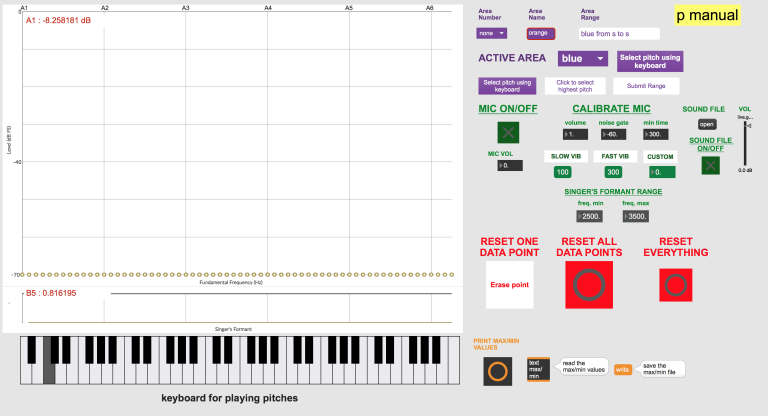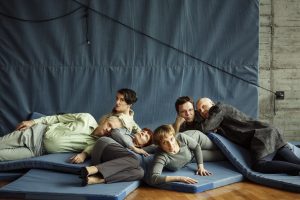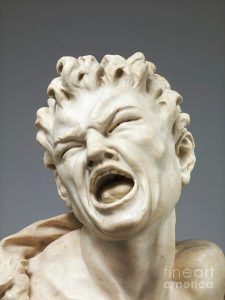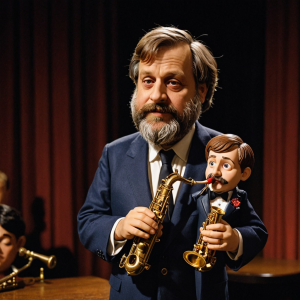The Voice Map Method

The Voice Map method helps the singers and composers communicate with each other. Miika Hyytiäinen has created it in his artistic doctoral studies at Sibelius Academy, University of Arts, Helsinki, DocMus.
Downloads
[These will be updated when the official version of the study is published]
Download the following zip file to your computer: Voice Map Analysis software: Stand-alone patch, Max/MSP not needed
Voice Map Analysis software: Source code
Abstract
Communication issues often occur between singers and composers in the context of creating new vocal music. The Voice Map Method (VMM), developed here, facilitates more fluent communication and thus supports the artistic process. The VMM consists of two parts: a computer-aided Voice Map Analysis (VMA) and a questionnaire entitled List of Good Questions. This systematic process involves collecting information about a specific singer’s voice; it reveals some of the most essential aspects of the singing voice, which is particularly beneficial to less experienced composers. During the VMA stage, the composer listens to the singer’s voice, to get to know it acoustically. Afterwards, both parties read through the VMA together and proceed to discuss it.
The VMA is based on the Voice Range Profile (VRP), an analytical tool used in voice studies to efficiently collect numerical data on the voice. The result of the VMA, the Voice Map, reveals the possibilities of the singer’s voice in visual form, indicating each area (‘area’ being analogous to ‘register’) and the dynamic range (range of sound pressure levels) of each tone. Lastly, the singer’s formant is analysed automatically and the audio is stored for later reference.
Field tests involving different voice types validate the technical functionality of the VMA and optimise the analysis process. Nevertheless, since the VMM is designed to improve communication between artists, the ultimate testing and validation happens in the artistic context, in the form of composing three operas.
The development is iterative: questions arising from the artistic work are analysed against the theoretical background for creating a new version of the VMM. This is then used in a new artistic work. The development project is grounded in communication theory, collaborative creativity (as per Keith Sawyer), and the analysis of the composer’s work. Furthermore, the voice studies provide a theoretical background for the vocal registers, singer’s formant, vibrato, voice range profile, and the German Fach system. While the Fach system itself is a fundamental component of the opera industry, it is often misapplied outside of that context. Structural gaps in the standard training programmes cause inexperienced composers to resort to the Fach system in an uninformed way, often composing unidiomatically and too vaguely for a voice type.
Tiivistelmä
Kun laulaja ja säveltäjä luovat uutta vokaalimusiikkia, on kommunikaatiossa usein haasteita. Voice Map Method (VMM) on menetelmä, joka tukee sujuvampaa kommunikaatiota ja siten auttaa myös taiteellisessa prosessissa. VMM koostuu kahdesta osasta: tietokoneavusteisesta analyysistä Voice Map Analysis (VMA) ja kysymyslistasta List of Good Questions. Tämä systemaattinen prosessi auttaa kokoamaan ja välittämään tietoa tietyn laulajan äänestä ja paljastaa sen tärkeitä ominaisuuksia, jotka ovat erityisen hyödyllisiä laulumusiikissa kokemattomalle säveltäjälle. VMA-prosessin aikana säveltäjä myös kuuntelee laulajan ääntä tutustuen siihen akustisesti. Myöhemmin molemmat osapuolet käyvät yhdessä läpi VMA:n tulokset ja jatkavat keskustelua sen pohjalta.
VMA perustuu analyyttiseen menetelmään nimeltä Voice Range Profile (VRP), jota logopediassa käytetään numeerisen datan tehokkaaseen keräämiseen äänestä. VMA:n tulos, Voice Map (äänikartta), näyttää laulajan äänen mahdollisuudet visuaalisessa muodossa. Kartta kuvaa äänen eri alueet (“alue”, ‘area’, on analoginen sanan “rekisteri” kanssa) ja jokaisen siihen kuuluvan äänen dynaamisia mahdollisuuksia (äänenpainetason ylä- ja alarajan). Lopuksi äänestä analysoidaan laulajan formanttia ja ääni tallennetaan mahdollista myöhempää tarkastelua varten.
VMA:a testattiin eri äänityyppejä edustavien laulajien kanssa, mikä vahvisti sen teknisen toimivuuden ja auttoi optimoimaan analyysiprosessin. Koska VMM on suunniteltu taiteilijoiden väliseen kommunikaatioon, voi lopullinen testaus kuitenkin tapahtua vain taiteellisessa kontekstissa. Menetelmää hyödynnettiin kolmen oopperan sävellystyössä.
Kehitystyö oli iteratiivista: taiteellisen työn herättämät kysymykset analysoitiin teoreettista viitekehystä vasten, mikä toimi innoittajana seuraavalla versiolle VMM:sta. Tätä puolestaan käytettiin uuden taiteellisen teoksen luomiseksi. Kehitystyön pohjana toimivat kommunikaatioteoriat, jaettu luovuus (collaborative creativity, Keith Sawyer) sekä säveltäjän työn analyysi. Lisäksi mukana on logopedian tarjoama teoreettinen pohja vokaalirekistereille, laulajan formantille, vibratolle ja VRP:lle. Fakkijärjestelmä taas on perustavanlaatuinen osa oopperateollisuutta, mutta toisissa konteksteissa sitä käytetään usein väärin. Koska säveltäjien peruskoulutuksessa on usein rakenteellisia aukkoja laulumusiikissa, he käyttävät fakkijärjestelmää tulkiten sitä väärin ja päätyvät säveltämään epäidiomaattisesti ja epämääräiselle äänityypille.




